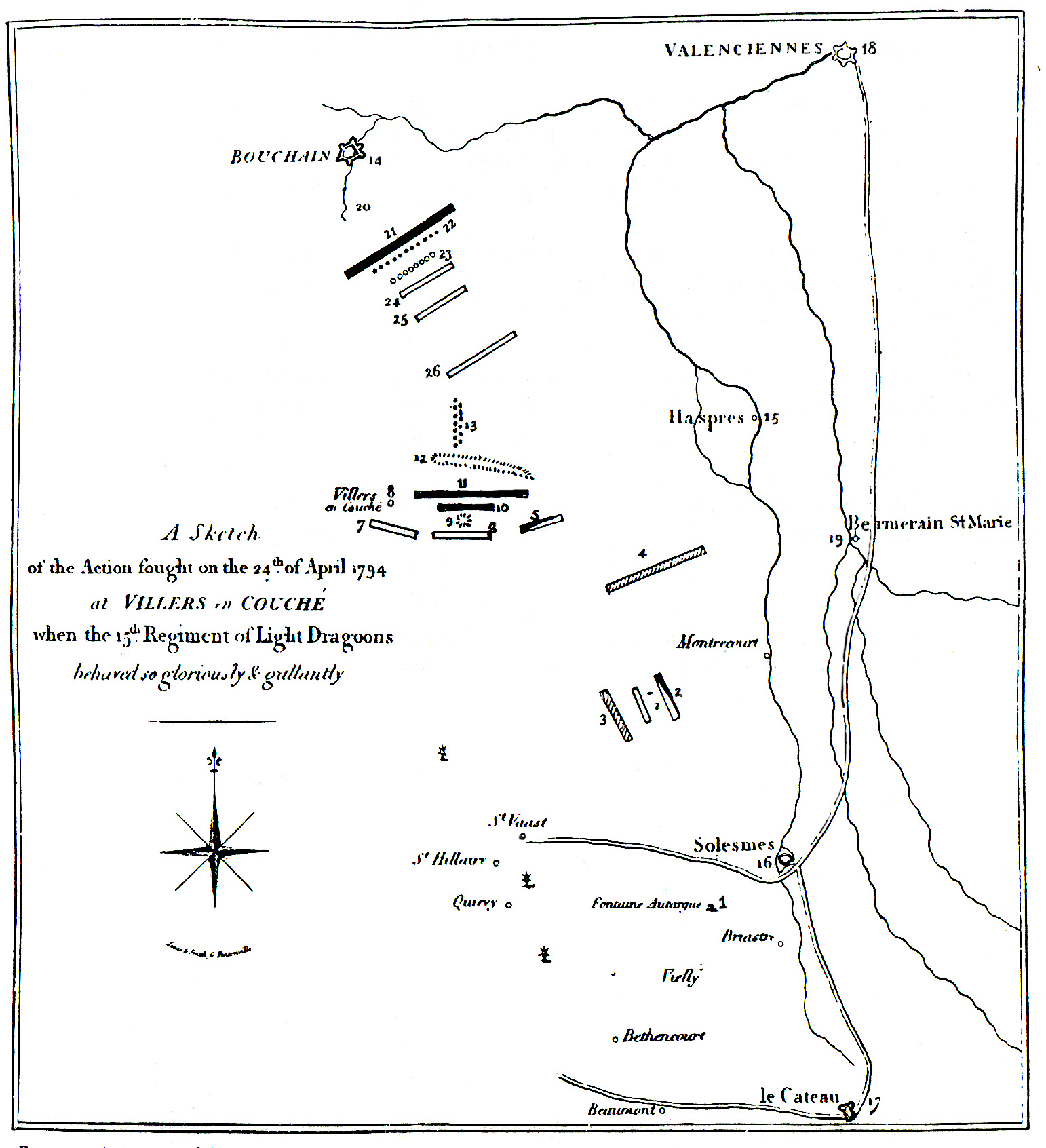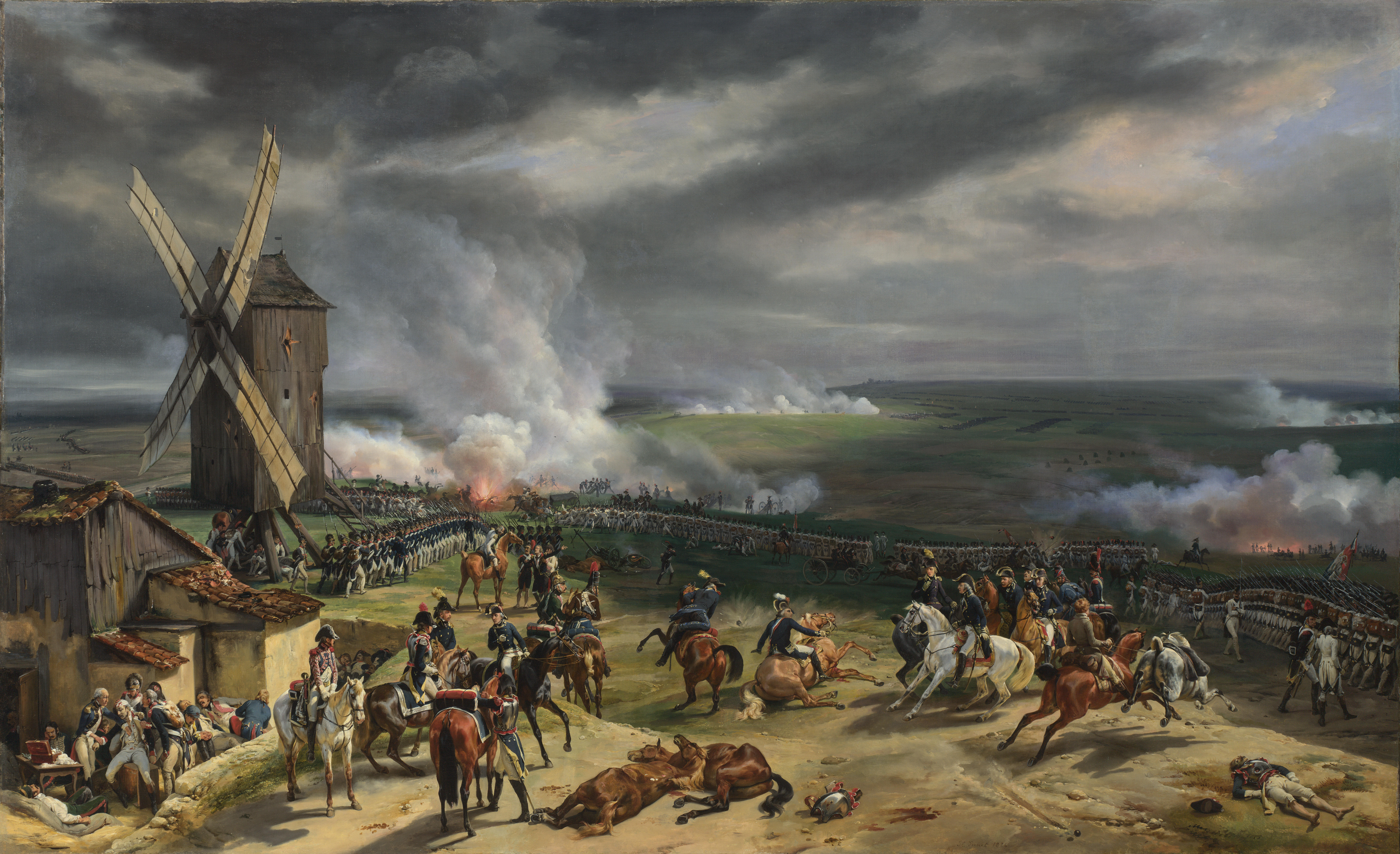|
Battle Of Villers-en-Cauchies
In the Battle of Villers-en-Cauchies, fought on 24 April 1794, a small Anglo-Austrian cavalry force routed a vastly more numerous French division during the Flanders Campaign of the French Revolutionary Wars. Villers-en-Cauchies is 15 km south of Valenciennes. Background At the beginning of the Flanders Campaign in 1794, the main Coalition army led by the Prince Josias of Saxe-Coburg-Saalfeld advanced against the French Army of the North under Charles Pichegru. By mid-April the Coalition began the Siege of Landrecies while the observation army took position in a broad semi-circle to cover the operation. On 23 April a French force was mustered in an attempt to cut off the Allied column of Ludwig von Wurmb from the rest of the observation army which consisted of the corps of François Sébastien de Croix de Clerfayt and Prince Frederick, Duke of York and Albany. Wurmb's command lay in a cordon of detachments between Denain and Hellesmes. All the available French troops fro ... [...More Info...] [...Related Items...] OR: [Wikipedia] [Google] [Baidu] |
War Of The First Coalition
The War of the First Coalition (french: Guerre de la Première Coalition) was a set of wars that several European powers fought between 1792 and 1797 initially against the constitutional Kingdom of France and then the French Republic that succeeded it. They were only loosely allied and fought without much apparent coordination or agreement; each power had its eye on a different part of France it wanted to appropriate after a French defeat, which never occurred. Noah Shusterman – ''De Franse Revolutie (The French Revolution).'' Veen Media, Amsterdam, 2015. (Translation of: ''The French Revolution. Faith, Desire, and Politics.'' Routledge, London/New York, 2014.) Chapter 7 (p. 271–312) : The federalist revolts, the Vendée and the beginning of the Terror (summer–fall 1793). Relations between the French revolutionaries and neighbouring monarchies had deteriorated following the Declaration of Pillnitz in August 1791. Eight months later, following a vote of the revolutionar ... [...More Info...] [...Related Items...] OR: [Wikipedia] [Google] [Baidu] |
Denain
Denain (; pcd, Dnain) is a commune in the Nord department in northern France. Denain had a population of 19,877, on a land area of 11.52 km² (4.448 sq mi). It is the largest of 47 communes which comprise the Communauté d'agglomération de la Porte du Hainaut, which in 2017 had a total population of 158,754. History A mere village in the beginning of the 19th century, its population rapidly increased from 1850 until 1962, when it had 29,467 inhabitants. Since then its population declined by about 30%. Its vicinity was the scene of the decisive victory gained in 1712 by Marshal Villars over the allies commanded by Prince Eugene of Savoy; and the battlefield is marked by a monolithic monument inscribed with the verses of Voltaire: "'" ("See in Denain bold Villars/Fighting the eagle of the Caesars"). Denain was an important centre in the industrial revolution, first for coal-mining from 1720, and steelworks from around 1839. The closure of the large Usinor steelworks ... [...More Info...] [...Related Items...] OR: [Wikipedia] [Google] [Baidu] |
Le Cateau-Cambrésis
Le Cateau-Cambrésis (, before 1977: ''Le Cateau'') is a commune in the Nord department in northern France. The term Cambrésis indicates that it lies in the county of that name which fell to the Prince-Bishop of Cambrai. Le Cateau station has rail connections to Paris, Maubeuge and Saint-Quentin. History *The Peace of Cateau-Cambrésis, ending the Italian Wars, was agreed there on 2–3 April 1559. * Until 1678, the city belonged to the Spanish Netherlands (now called Belgium). France conquered the city officially by the treaty of Nijmegen signed in 1678. *On 28 March 1794, allied forces under the prince of Coburg, defeated French forces at Le Cateau. *Le Cateau formed the right wing of the front of II Corps of the British Expeditionary Force at the Battle of Le Cateau on 26 August 1914, during its withdrawal from the Battle of Mons. Heraldry Population Matisse Museum The '' Musée Départemental Henri Matisse'' installed in the Palais Fénelon in the center of Le Catea ... [...More Info...] [...Related Items...] OR: [Wikipedia] [Google] [Baidu] |
Le Quesnoy
Le Quesnoy (; pcd, L' Kénoé) is a commune and small town in the east of the Nord department of northern France. It was part of the historical province of French Hainaut. It had a keynote industry in shoemaking before the late 1940s, followed by a chemical factory and dairy, giving way to its weekly market, tourism, local commuting to elsewhere such as Valenciennes and local shops. Le Quesnoy's inhabitants are known as ''Quercitains''. Economy The town of Le Quesnoy has somehow missed much of the Industrial Revolution. Unlike the neighboring towns of Valenciennes or Maubeuge, iron/steel works did not take hold. The lack of wealth underground and of a major transportation route partly explains this. The authorities, however, took note of this weakness and proposed the Ecaillon canal from Sambre to Scheldt; considered but abandoned because of low water yield in the forest of Mormal. Shoemaking was a major local industry until at least 1945, when a hundred shoemakers were s ... [...More Info...] [...Related Items...] OR: [Wikipedia] [Google] [Baidu] |
Avesnes-le-Sec
Avesnes-le-Sec () is a commune in the Nord department in northern France. Population Heraldry See also * Chemin de fer du Cambrésis *Communes of the Nord department The following is a list of the 648 communes of the Nord department of the French Republic. The communes cooperate in the following intercommunalities (as of 2020):Communes of Nord (French department) French Hainaut {{Nord-geo-stub ... [...More Info...] [...Related Items...] OR: [Wikipedia] [Google] [Baidu] |
Iwuy
Iwuy () is a commune in the Nord department in northern France. Heraldry See also *Communes of the Nord department The following is a list of the 648 communes of the Nord department of the French Republic. The communes cooperate in the following intercommunalities (as of 2020):Official website Aujourd'hui à Iwuy Communes of Nord (French department) {{Nord-geo-stub ... [...More Info...] [...Related Items...] OR: [Wikipedia] [Google] [Baidu] |
Noyelles-sur-Selle
Noyelles-sur-Selle (, literally ''Noyelles on Selle'') is a commune in the Nord department in northern France. Heraldry Notable people from Noyelles * Francisco Luis Héctor de Carondelet, colonial governor for the Spanish Empire See also *Communes of the Nord department The following is a list of the 648 communes of the Nord department of the French Republic. The communes cooperate in the following intercommunalities (as of 2020):Noyellessurselle {{Nord-geo-stub ... [...More Info...] [...Related Items...] OR: [Wikipedia] [Google] [Baidu] |
Hordain
Hordain () is a commune in the Nord department in northern France. Heraldry See also *Communes of the Nord department The following is a list of the 648 communes of the Nord department of the French Republic. The communes cooperate in the following intercommunalities (as of 2020):Communes of Nord (French department) {{Nord-geo-stub ... [...More Info...] [...Related Items...] OR: [Wikipedia] [Google] [Baidu] |
Douchy-les-Mines
Douchy-les-Mines () is a commune in the Nord department in northern France. Geography Douchy-les-Mines located near the A2 motorway between Valenciennes and Cambrai. It lies adjacent to the south of Denain and is a part of the urban area of Valenciennes. Demography and culture In 2015, Douchy-les-Mines had 10,783 inhabitants, an increase of 3.43% compared to 2010. The city has two cinemas (Cinéma Jean Renoir and Le Cinéma de l'Imaginaire) and it hosts the Regional Centre of Photography. Landmarks * Maingoval Park (Parc Maingoval) * Le Château de la Barbière Notable people * Charles Alexandre Crauk, painter (1819-1905) * Jean-Baptiste Dupilet, French politician (1880-1952) * Robert Mintkewicz, bicycle racer (born 1947) Heraldry International relations Douchy-les-Mines is twinned with: * Méguet, Burkina Faso * Mielec, Poland * Vila Nova de Poiares, Portugal See also *Communes of the Nord department The following is a list of the 648 communes of th ... [...More Info...] [...Related Items...] OR: [Wikipedia] [Google] [Baidu] |
Scheldt
The Scheldt (french: Escaut ; nl, Schelde ) is a river that flows through northern France, western Belgium, and the southwestern part of the Netherlands, with its mouth at the North Sea. Its name is derived from an adjective corresponding to Old English ' ("shallow"), Modern English ''shoal'', Low German ''schol'', West Frisian ''skol'', and Swedish (obsolete) ''skäll'' ("thin"). Course The headwaters of the Scheldt are in Gouy, in the Aisne department of northern France. It flows north through Cambrai and Valenciennes, and enters Belgium near Tournai. Ghent developed at the confluence of the Lys, one of its main tributaries, and the Scheldt, which then turns east. Near Antwerp, the largest city on its banks, the Scheldt flows west into the Netherlands toward the North Sea. Originally there were two branches from that point: the Oosterschelde (Eastern Scheldt); and the Westerschelde (Western Scheldt). In the 19th century, however, the Dutch built a dyke that cut ... [...More Info...] [...Related Items...] OR: [Wikipedia] [Google] [Baidu] |
Jacques Philippe Bonnaud
Jacques Philippe Bonnaud or Bonneau (11 September 1757 – 30 March 1797) commanded a French combat division in a number of actions during the French Revolutionary Wars. He enlisted in the French Royal Army as cavalryman in 1776 and was a non-commissioned officer in 1789. He became a captain in the 12th Chasseurs à Cheval Regiment in 1792. The unit fought at Valmy, Jemappes, Aldenhoven, Neerwinden, Raismes, Caesar's Camp and Wattignies, and he was wounded twice. In January 1794 he was promoted to general officer. In April 1794, he reluctantly accepted command of a division that had been cut to pieces at Villers-en-Cauchies and Troisvilles, and this at a time when failed generals often were sent to the guillotine. He led his troops at Courtrai, Tourcoing and in the invasion of the Dutch Republic. He fought in the War in the Vendée the following year, briefly leading the '' Army of the Coasts of Cherbourg''. In the Rhine Campaign of 1796 he led a cavalry division in combat ... [...More Info...] [...Related Items...] OR: [Wikipedia] [Google] [Baidu] |
Jean Proteau
Jean may refer to: People * Jean (female given name) * Jean (male given name) * Jean (surname) Fictional characters * Jean Grey, a Marvel Comics character * Jean Valjean, fictional character in novel ''Les Misérables'' and its adaptations * Jean Pierre Polnareff, a fictional character from ''JoJo's Bizarre Adventure'' Places * Jean, Nevada, USA; a town * Jean, Oregon, USA Entertainment * Jean (dog), a female collie in silent films * "Jean" (song) (1969), by Rod McKuen, also recorded by Oliver * ''Jean Seberg'' (musical), a 1983 musical by Marvin Hamlisch Other uses * JEAN (programming language) * USS ''Jean'' (ID-1308), American cargo ship c. 1918 * Sternwheeler Jean, a 1938 paddleboat of the Willamette River See also *Jehan * * Gene (other) * Jeanne (other) * Jehanne (other) * Jeans (other) * John (other) John is a common English name and surname: * John (given name) * John (surname) John may also refer to: New Te ... [...More Info...] [...Related Items...] OR: [Wikipedia] [Google] [Baidu] |


